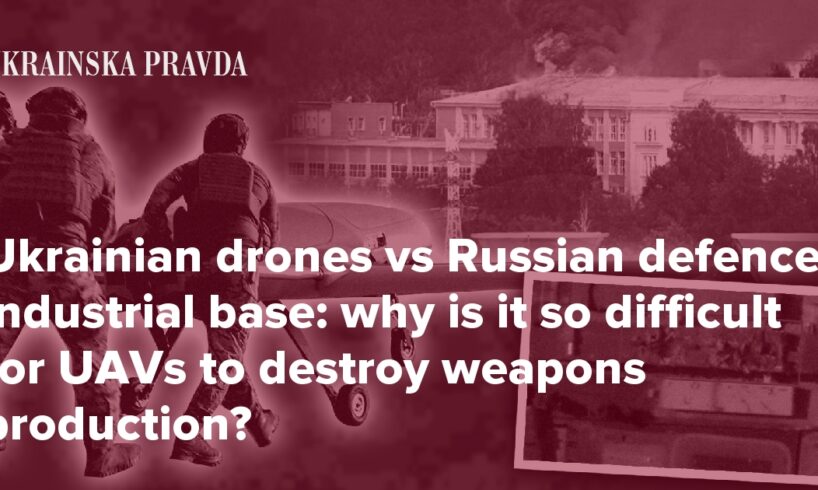
Over the past two and a half years, Ukrainian long-range drones have been targeting Russian warehouses and radar positions with expensive equipment and disabling airports. These strikes have forced the Russians to reposition air defence systems, invest resources in protecting facilities and suffer financial losses. Ultimately, they also produce a psychological effect, as the enemy feels the war on its own territory.
However, the most prominent strikes have been those against Russian energy infrastructure, carried out in response to Russia’s terror attacks with Shahed drones and missiles. Throughout 2023 and early 2024, Ukrainian drones methodically targeted energy facilities, demonstrating the ability to cripple parts of Russia’s oil refining industry. These strikes also weakened Russia’s position during negotiations on an “energy truce” in spring 2025, a fragile agreement that is still holding.
This “mutual” pause in attacks on energy facilities has shifted the focus of long-range strikes to military-industrial targets. But are attacks on the defence sector as effective as those on oil refineries?
Advertisement:
Russia’s defence industry facilities are far better protected and are already changing the rules of the game. Hitting them requires greater range, precision and effectiveness. The complex structure of these new targets makes the task more difficult. Damaging a site does not necessarily mean rendering it inoperable.
Why has it become significantly more difficult to carry out effective strikes on Russian facilities and what technological solutions is Ukraine seeking?
From oil refineries to arms factories
This article focuses exclusively on strikes carried out by long-range UAVs – specifically those documented in open sources, visually confirmed as successful (i.e. when a drone did in fact hit the target) and conducted by Ukrainian drones, not ballistic or cruise missiles.
Confirmation of successful strikes relies on geolocation of publicly available videos and satellite imagery. Ukrainian OSINT analysts such as Cyber Boroshno, Harbuz and others gather footage from social media, determine the coordinates of targets through triangulation based on identifiable landmarks (buildings, terrain, road networks, etc.) and compare these findings with satellite images and official statements.
By comparing archived and current satellite images of varying resolutions, analysts can detect signs of fires and damage, such as destroyed roofs or burnt-out hangars. Additional sources include military bloggers, Telegram channels and open-source databases, all of which contribute to a relatively high level of confidence in each documented case.
An example of geolocation of an impact
However, not every strike can be confirmed – sometimes due to a lack of video footage, poor weather preventing satellite imagery, or simply the classified nature of the operation. Therefore this analysis does not cover every strike Ukraine has carried out against Russian targets.
Between 1 January and 19 March 2025, Ukraine actively targeted Russia’s rear energy infrastructure. This phase concluded with a final high-profile confirmed strike on an energy facility – the Kavkazskaya oil depot.
A total of 32 successful strikes were recorded in that period, broken down as follows:
Energy facilities – 24
Defence industrial base– 7
Military facilities (airfields, depots, units) – 1
This phase lasted 78 days, or roughly 11.1 weeks, resulting in an average of 2.9 successful strikes per week.
In the second phase – from 20 March to 30 June – the pattern changed. The total number of confirmed successful strikes was 24, but their distribution had shifted significantly:
Defence industrial base – 19
Military facilities – 5
Energy facilities – 0
Energy infrastructure disappeared from the target map. The focus shifted instead to military-industrial production sites: factories producing ammunition, explosives, electronics, fibre optics and component bases for artillery and missile systems.
This phase lasted 103 days (around 14.7 weeks), bringing the average frequency of successful strikes down to 2.33 per week.
In other words, there has been a noticeable drop in the number of confirmed strikes, though it falls within the margin of error – from 2.9 to 2.33 strikes per week. The more important question is what actual damage these strikes have caused.
Why is it so difficult to destroy an arms factory?
It is important to understand that expectations from Ukrainian drone strikes have changed over time. In the early stages of the war, success was measured by the very fact that a UAV had managed to bypass Russian air defences, reach deep into the rear and create a psychological impact. Later, a single drone hitting a target was seen as a success.
Today, flights of dozens of Ukrainian drones deep into Russian territory or the destruction of an oil depot no longer surprise anyone. There is now an expectation of consistent, daily results: halted production, fires, detonations and so on.
This evolution in expectations for long-range strikes is perfectly logical – but it also significantly raises the bar in terms of complexity.
In the case of oil refineries, such significant and systemic results are easier to achieve. These facilities have open layouts and are densely interconnected by technological processes operating under high pressure and temperature. Damaging just one unit or storage tank often causes a domino effect – pressure drops, fire breaks out, the system shuts down automatically and the entire facility ceases operation.
The defence industrial base, however, is a different matter. These are fundamentally different types of facilities with different layouts, levels of protection and resistance to damage. Achieving a noticeable result here is much more difficult.
Even during the Second World War, much of the Soviet Union’s defence industrial base was deliberately relocated far from the front lines, deep into the rear. This laid the foundation for a systemic logic: critical weapons production must be kept as safe and as distant from potential enemies as possible.
Advertisement:
For example, the manufacturer of T-90M Proryv tanks and upgraded T-72B3/T-72B1 models – Uralvagonzavod – is located in Nizhny Tagil, about 1,700 km from the Russian-Ukrainian border.
Continuing this Soviet-era approach, Russia has built a large system for producing Shahed-type drones in the Alabuga Special Economic Zone in Tatarstan, about 1,200 km from the front line.
To understand just how difficult it is to strike such a facility – even if a drone manages to reach it – we only need to study the layout of Uralvagonzavod’s production site.
Diagram of Uralvagonzavod’s layout
The factory is built like a scaly organism. Each critical process has its own “island” – in the event of a fire, the flames remain contained and do not spread to adjacent areas. The most valuable assembly lines – the sixth, tenth and eleventh – are hidden deep inside a “sandwich” of auxiliary buildings, meaning any attacker must first breach the outer layers.
Energy and transport arteries are duplicated: there are at least two boiler houses and three parallel pipelines. If one branch is knocked out, the others can take over the load. The walls between buildings serve as concrete firebreaks: an explosion in a neighbouring sector is blocked by a firewall, while production on either side continues uninterrupted.
Finally, a buffer zone of logistics and administrative buildings surrounds the perimeter. These structures absorb the initial impact, giving the “core” of the plant time to isolate itself and keep operating. In essence, Uralvagonzavod is not a fortress with a single drawbridge – it is a system of interlocking compartments: destroying one does not mean flooding the entire complex.
To illustrate this more clearly, let’s examine the individual workshops:
No. on the diagram
Main function
How they are protected
6, 10, 11
(yellow-orange “cores” beneath blue and red routes)
Assembly + mechanical processing (“heart” of the conveyor)
central “island” / firewalls / parallel lines
3, 8, 12, 17
(light blue/grey blocks along the central axis)
Forge, repairs, power units
spread along the axis / semi-underground
20–23, 25
(large turquoise “plate” on the right)
Casting and armour rolling
rearmost zone / dedicated railway loop
1, 2, 30–32
(wedge along the left flank and “beak” at the top)
Logistics + administration
perimeter “buffer” / duplicated gates
Routes 1–3
(blue, dashed, red)
Internal arteries
three parallel corridors / rapid containment
How are the factories protected?
But to even attempt to destroy such an object, you first must reach it.
Conventional air defence along the route is no longer Russia’s only shield. Increasingly, we see that critical facilities – especially those related to the defence industrial base – are protected directly on their premises. This refers to the deployment of surface-to-air missile systems directly at factories – usually the Pantsir air defence system, which has proven to be one of the most effective means against Ukrainian drones.
To enhance visibility and the firing sector, these systems are installed on special mounds or towers. These platforms are clearly visible in satellite images – for example, at the Alabuga Special Economic Zone, where Shahed drones are produced. One Pantsir system is located in the settlement of Kuzmino-Gat, right in the middle of a residential area – it protects the Tambov Gunpowder Plant. Another example is an air defence tower on the premises of military unit 3058 or a fortified mound near the Yakov Sverdlov Plant, where two new systems recently appeared.
The placement of air defence systems in residential areas is common practice. A recent example is the city of Zelenograd, where debris from TKB-1055 Gvozd missiles – used by Pantsir – was found in the streets after air defence systems were operating. This once again confirms that the systems are deployed directly in urban neighbourhoods.
Debris from a Russian air defence missile on a city street
One of the notable changes in response to the mass use of attack UAVs is the installation of mesh structures not only above roofs but also around the entire perimeter of buildings. Sometimes these are not traditional metal meshes but lightweight screens made of other materials. However, the principle remains the same: to create a physical obstacle in the path of drones. For example, at the Sverdlov plant, such meshes have been installed around the boiler house and production workshop.
In the early stages, these nets could partially dissipate drones’ kinetic energy and reduce the likelihood of a hit. But now their effectiveness is diminishing due to modifications in Ukrainian strike drones. What’s more, nets are increasingly having the opposite effect – they expose which workshops are crucial to the facility’s operation. One recent example was the strike on the Energia plant in the city of Yelets on the night of 14-15 July. Despite its mesh protection, the building was hit.
Interestingly, Russia is starting to adopt Ukrainian counter-drone tactics. In particular, the Russians are deploying mobile fire teams in certain areas – similar to those used by the Ukrainian defence forces. Some companies are also recruiting volunteers to form anti-drone FPV units that will intercept Ukrainian attack UAVs directly near the facilities.
Thus, unlike energy facilities, most of the Russian defence industrial base’s companies have a systematic protective architecture formed back in Soviet times – from rearward locations to well-thought-out internal logistics and structural segmentation. These factories were designed to ensure that even in the event of a strike, critical processes could continue: workshops are duplicated, energy and transport have several independent branches, and firewall partitions minimise the risk of large-scale damage.
To this historical foundation, modern tools are added – for example, deploying Pantsir systems directly on the premises and installing anti-drone nets around key buildings. Moreover, Russia has begun adopting Ukrainian approaches: deploying mobile fire groups to intercept drones and forming anti-air FPV drone crews at the companies themselves. This enables a quick response to threats at the final segment of the attack route.
Advertisement:
However, these measures do not make the targets completely unreachable – they merely change the nature of the task. And to identify vulnerabilities in such a system, not only the overall architecture but also specific technological and logistical nodes should be carefully studied.
New challenges for Ukrainian deep strikes
The effectiveness of deep strikes depends not only on the technical characteristics of UAVs. The outcome is influenced by application tactics, the quality of intelligence and target designation, the level of operator training, weather conditions, time of day, seasonal factors, and so on.
Currently, we are observing an expansion of the attack UAV arsenal not only in terms of types but also functionality: from explosive payload to speed and range. Whereas earlier the focus was on the somewhat “universal” AN‑196 Liutyi and the smaller Bober, now new products are appearing on the scene. For example, the FP‑1 UAV recently successfully struck the Krasnozavodsk Chemical Plant.
FP‑1
In addition to classic propeller models, a segment of jet drones is developing which are closer in nature to cruise missiles. These include the Peklo and the Palianytsia. These products have turbojet engines, allowing them to reach speeds of over 600 km/h and making interception more difficult. Their use is less publicised; however, photos of debris occasionally appear at strike sites.
Debris of the Ukrainian Peklo missile
Simultaneously, existing models are being modified. For example, on Liutyi the undercarriage has been removed – likely to reduce drag, free up space for additional fuel or a larger warhead. Launches are no longer conducted from airfields but from field mobile platforms, reducing risk to crews.
Liutyi without landing gear
Besides the technical evolution of the UAVs themselves, Ukraine is improving tactical approaches to attack UAV deployment. It is worth remembering that the fact a UAV has been downed does not necessarily mean the operation failed. In many cases, this is part of a broader plan.
Increasingly often, decoy drones are used – cheap UAVs that simulate an attack to distract air‑defence systems. Also practised is the tactic of a “frontal strike”: one or several combat drones deliberately enter an area known to have air defence, forcing it to open fire. Meanwhile, the main attack group approaches from the flanks or bypasses the air defences – thus successfully reaching the target.
Advertisement:
Another element of modern tactics is the use of jet UAVs. Due to their high speed, the Russians often perceive them as cruise missiles, making them a priority target for air defence. Meanwhile, slower but more powerful UAVs penetrate the target from another direction.
Over two and a half years, Ukrainian deep strikes have evolved from “just reaching the rear” to “pinpoint hits that halt production”. The first phase involved strikes on energy infrastructure, where a single wave of explosions could paralyse the entire technological chain. The second phase is more complex – attacks on the defence industrial base: dispersed, duplicated and multilevel-protected companies.
Ukraine plans to produce around 30,000 attack UAVs in 2025. Meanwhile, Russia, as reported by Defence Intelligence of Ukraine, is planning at least twice as many. Such a difference in drone potential serves as a reminder that Ukraine should not compete by volume, but seek technological asymmetric responses to threats and identify vulnerabilities.
But even when a UAV does not destroy the target, the operation still delivers a multi‑layer effect:
Psychological: following unexpected attempted strikes, cases have been recorded in which some Russian military sites have reduced their activity, and civilians are beginning to realise that there is no “safe rear” and the war is not somewhere in Ukraine – it is already reaching their cities.
Advertisement:
Financial: each strike forces the Kremlin to spend hundreds of millions of dollars on air‑defence missiles, embankments, anti-drone nets and logistics reconstruction. And that excludes attacks with decoy drones, which forced Russia to constantly implement the Kovyor plan at major aviation hubs, resulting in billion-dollar losses for airlines and airports. [A Kovyor plan is an airport operational safety procedure for airport services and personnel when an unidentified object appears in the sky – ed.]
Military: air‑defence forces are tied up, opening corridors for other strikes.
Preventive: in the event of escalation, it is possible to immediately revert to the tried‑and‑tested strikes on energy infrastructure.
Advertisement:
That is why it is incorrect to assess the effectiveness of deep strikes solely through videos of explosions or comparisons with unsuccessful cases. A comprehensive analysis is required, comparing expenditure (the cost of long-range drones is constantly changing) with all visible and indirect results. Only in this way can we determine whether Ukrainian long-range drones are fulfilling their purpose or have lost their relevance.
Author: Vadym Hlushko
Translation: Anna Kybukevych, Yelyzaveta Khodatska
Editing: Susan McDonald





